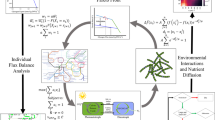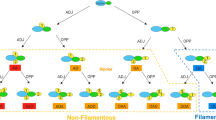Abstract
A structured-segregated dynamic model for biomass growth, sucrose utilization and flavonoid production in Ocimum tenuiflorum suspension culture is proposed, considering a dynamic heterogeneous population of viable active, viable nonactive and dead cell. The sucrose hydrolysis (into glucose and fructose), substrate uptake by biomass and intracellular flavonoid production are modelled using Contois kinetics, a competitive double-substrate Monod, and Luedeking–Piret model, respectively. The conversion of active to viable-nonactive biomass has been formulated as a function of the total substrate and biomass concentrations. Parameters for the dynamic model are evaluated while minimizing the sum of square errors between modelled and measured biomass, cell viability, glucose, fructose and intracellular flavonoid contents. Bootstrap confidence intervals and dynamic relative sensitivity analysis of these model parameters are presented. The knowledge gained from the population-based model in plant suspension culture can provide the basic framework for prediction and optimization of the bioprocess system for phytochemical production.




Similar content being viewed by others
Abbreviations
- X:
-
Biomass concentration (g.l−1)
- S:
-
Substrate concentration (g.l−1)
- K:
-
Half saturation constant or Contois parameter (g.l−1)
- P:
-
Product concentration (g.l−1)
- m:
-
Mass conversion factor from sucrose to glucose or fructose (g.g−1)
- Y:
-
Yield coefficient (g.g−1)
- v:
-
Cell viability (g.g−1)
- τ:
-
Function for activity loss
- ϕ:
-
Biomass equivalent of substrate in activity loss
- µ:
-
Specific growth rate (d−1)
- k:
-
Rate constant for activity loss or death (d−1)
- α:
-
Growth associated product constant (g.g−1)
- β:
-
Growth nonassociated product constant (g.g−1.d−1)
- γ:
-
Product release coefficient in cell lysis (g.g−1)
- a:
-
Active-viable cell
- n:
-
Nonactive-viable cell
- d:
-
Dead cell
- t:
-
Total cell
- ac:
-
Activity loss
- G:
-
Glucose
- F:
-
Fructose
- L:
-
Cell lysis
- h:
-
Substrate hydrolysis
- c:
-
Contois function
- gs:
-
Conversion of sucrose to glucose
- fs:
-
Conversion of sucrose to fructose
- X/SG :
-
Biomass from glucose
- X/SF :
-
Biomass from fructose
- P/SG :
-
Product from glucose
- P/SF :
-
Product from fructose
References
Pattanayak P, Behera P, Das D, Panda S (2010) Ocimum sanctum Linn. A reservoir plant for therapeutic applications: An overview. Pharmacogn Rev 4:95–105. https://doi.org/10.4103/0973-7847.65323
Singh V, Sarika A, Omparakash V (2010) Ocimum Sanctum (tulsi): Bio-pharmacological activities. WebmedCentral Pharmacol 1:WMC001046. https://doi.org/10.9754/journal.wmc.2010.001046
Uma Devi P, Satyamitra M (2004) Protection against prenatal irradiation-induced genomic instability and its consequences in adult mice by Ocimum flavonoids, orientin and vicenin. Int J Radiat Biol 80:653–662. https://doi.org/10.1080/09553000400005494
Yamani HA, Pang EC, Mantri N, Deighton MA (2016) Antimicrobial activity of Tulsi (Ocimum tenuiflorum) essential oil and their major constituents against three species of bacteria. Front Microbiol 7:681. https://doi.org/10.3389/fmicb.2016.00681
Uma Devi P, Ganasoundari A, Vrinda B, Srinivasan KK, Unnikrishnan MK (2000) Radiation protection by the ocimum flavonoids orientin and vicenin: mechanisms of action. Radiat Res 154:455–460. https://doi.org/10.1667/0033-7587(2000)154[0455:RPBTOF]2.0.CO;2
Vats V, Yadav SP, Grover JK (2004) Ethanolic extract of Ocimum sanctum leaves partially attenuates streptozotocin-induced alterations in glycogen content and carbohydrate metabolism in rats. J Ethnopharmacol 90:155–160. https://doi.org/10.1016/j.jep.2003.09.034
Hannan JMA, Marenah L, Ali L, Rokeya B, Flatt PR, Abdel-Wahab YHA (2006) Ocimum sanctum leaf extracts stimulate insulin secretion from perfused pancreas, isolated islets and clonal pancreatic β-cells. J Endocrinol 189:127–136. https://doi.org/10.1677/joe.1.06615
Mahajan N, Rawal S, Verma M, Poddar M, Alok S (2013) A phytopharmacological overview on Ocimum species with special emphasis on Ocimum sanctum. Biomed Prev Nutr 3:185–192. https://doi.org/10.1016/j.bionut.2012.08.002
Pandey P, Singh S, Banerjee S (2019) Ocimum basilicum suspension culture as resource for bioactive triterpenoids: yield enrichment by elicitation and bioreactor cultivation. Plant Cell Tissue Organ Cult 137:65–75. https://doi.org/10.1007/s11240-018-01552-9
Marzouk AM (2009) Hepatoprotective triterpenes from hairy root cultures of Ocimum basilicum L Zeitschrift fur Naturforsch - Sect C. J Biosci 64:201–209. https://doi.org/10.1515/znc-2009-3-409
Kintzios S, Kollias H, Straitouris E, Makri O (2004) Scale-up micropropagation of sweet basil (Ocimum basilicum L.) in an airlift bioreactor and accumulation of rosmarinic acid. Biotechnol Lett 26:521–523. https://doi.org/10.1023/B:BILE.0000019561.89044.30
Yadavalli V (2019) Evaluation of anticancer compounds from suspension cultures of Holy Basil (Ocimum sanctum L.). Int J Green Pharm 13:98–102
Vyas P, Mukhopadhyay K (2018) Elicitation of phenylpropanoids and expression analysis of PAL gene in suspension cell culture of Ocimum tenuiflorum L. Proc Natl Acad Sci India Sect B - Biol Sci 88:1207–1217. https://doi.org/10.1007/s40011-017-0858-8
Mathew R (2012) Effect of methyl jasmonate and chitosan on growth characteristics of Ocimum basilicum L., Ocimum sanctum L. and Ocimum gratissimum L. cell suspension cultures. African J Biotechnol 11:4759–4766. https://doi.org/10.5897/ajb11.3183
Dunn IJ, Heinzle E, Ingham J, Přenosil JE (2003) Biological Reaction Engineering: Dynamic Modelling Fundamentals with Simulation Examples, 2nd edn. Wiley-VCH Verlag GmbH & Co, KGaA
Schlatmann JE, ten Hoopen HJG, Heijnen JJ (1999) A simple structured model for maintenance, biomass formation, and ajmalicine production by nondividingCatharanthus roseus cells. Biotechnol Bioeng 66:147–157. https://doi.org/10.1002/(SICI)1097-0290(1999)66:3<147:AID-BIT2>3.0.CO;2-N
Chattopadhyay S, Farkya S, Srivastava AK, Bisaria VS (2002) Bioprocess considerations for production of secondary metabolites by plant cell suspension cultures. Biotechnol Bioprocess Eng 7:138–149. https://doi.org/10.1007/BF02932911
Maschke RW, Geipel K, Bley T (2015) Modeling of plant in vitro cultures: Overview and estimation of biotechnological processes. Biotechnol Bioeng 112:1–12. https://doi.org/10.1002/bit.25346
Kolewe ME, Henson MA, Roberts SC (2011) Analysis of aggregate size as a process variable affecting paclitaxel accumulation in Taxus suspension cultures. Biotechnol Prog 27:1365–1372. https://doi.org/10.1002/btpr.655
Mailier J, Delmotte A, Cloutier M, Jolicoeur M, Vande WA (2011) Parametric sensitivity analysis and reduction of a detailed nutritional model of plant cell cultures. Biotechnol Bioeng 108:1108–1118. https://doi.org/10.1002/bit.23030
Rezali NI, Jaafar Sidik N, Saleh A, Osman NI, Mohd Adam NA (2017) The effects of different strength of MS media in solid and liquid media on in vitro growth of Typhonium flagelliforme. Asian Pac J Trop Biomed 7:151–156. https://doi.org/10.1016/j.apjtb.2016.11.019
Savita VGS, Nagpal A (2011) In vitro selection of calli of Citrus jambhiri Lush. for tolerance to culture filtrate of Phytophthora parasitica and their regeneration. Physiol Mol Biol Plants 17:41–47. https://doi.org/10.1007/s12298-010-0046-2
Arias JP, Zapata K, Rojano B, Arias M (2016) Effect of light wavelength on cell growth, content of phenolic compounds and antioxidant activity in cell suspension cultures of Thevetia peruviana. J Photochem Photobiol B Biol 163:87–91. https://doi.org/10.1016/j.jphotobiol.2016.08.014
Mohamad Puad NI, Abdullah TA (2018) Monitoring the Growth of Plant Cells in Suspension Culture. Multifaceted Protocol in Biotechnology. Springer, Singapore, pp 203–214
Khanpour-Ardestani N, Sharifi M, Behmanesh M (2015) Establishment of callus and cell suspension culture of Scrophularia striata Boiss.: an in vitro approach for acteoside production. Cytotechnology 67:475–485. https://doi.org/10.1007/s10616-014-9705-4
Jacyn Baker C, Mock NM (1994) An improved method for monitoring cell death in cell suspension and leaf disc assays using Evans Blue. Plant Cell Tissue Organ Cult 39:7–12. https://doi.org/10.1007/BF00037585
Castro-Concha LA, Escobedo RM, Miranda-Ham M de L (2006) Measurement of cell viability in in vitro cultures. In: Methods in molecular biology (Clifton, N.J.). Humana Press, New Jersey, pp 71–76
Wang J, Qian J, Yao L, Lu Y (2015) Enhanced production of flavonoids by methyl jasmonate elicitation in cell suspension culture of Hypericum perforatum. Bioresour Bioprocess 2(1):5. https://doi.org/10.1186/s40643-014-0033-5
Pękal A, Pyrzynska K (2014) Evaluation of aluminium complexation reaction for flavonoid content assay. Food Anal Methods 7:1776–1782. https://doi.org/10.1007/s12161-014-9814-x
Sultana B, Fatima B, Mushtaq M (2014) In vitro synergism of antimutagenic and antioxidant activities of Phoenix dactylifera fruit. Food Sci Biotechnol 23(3):881–887. https://doi.org/10.1007/s10068-014-0118-0
Li C, Yuan YJ, Wu JC, Hu ZD (2003) A structured kinetic model for suspension cultures of Taxus chinensis var. mairei induced by an oligosaccharide from Fusarium oxysporum. Biotechnol Lett 25:1335–1343. https://doi.org/10.1023/A:1024980420790
Choi J-W, Kim Y-K, Lee WH, Pedersen H, Chin C-K (1999) Kinetic model of cell growth and secondary metabolite synthesis in plant cell culture of Thalictrum rugosum. Biotechnol Bioprocess Eng 4:129–137. https://doi.org/10.1007/BF02932383
Yoon H, Klinzing G, Blanch HW (1977) Competition for mixed substrates by microbial populations. Biotechnol Bioeng 19:1193–1210. https://doi.org/10.1002/bit.260190809
Dogan G (2007) Bootstrapping for confidence interval estimation and hypothesis testing for parameters of system dynamics models. Syst Dyn Rev 23:415–436. https://doi.org/10.1002/sdr.362
Yue H, Brown M, Knowles J, Wang H, Broomhead DS, Kell DB (2006) Insights into the behaviour of systems biology models from dynamic sensitivity and identifiability analysis: a case study of an NF-kappaB signalling pathway. Mol Biosyst 2:640–649. https://doi.org/10.1039/b609442b
Yang Y, He F, Yu LJ (2008) Dynamics analyses of nutrients consumption and flavonoids accumulation in cell suspension culture of Glycyrrhiza inflata. Biol Plant 52:732–734. https://doi.org/10.1007/s10535-008-0141-1
Fett-Neto AG, Zhang WY, Dicosmo F (1994) Kinetics of taxol production, growth, and nutrient uptake in cell suspensions of Taxus cuspidata. Biotechnol Bioeng 44:205–210. https://doi.org/10.1002/bit.260440209
Pépin M-F, Archambault J, Chavarie C, Cormier F (1995) Growth kinetics of vitis vinifera cell suspension cultures: I Shake flask cultures. Biotechnol Bioeng 47:131–138. https://doi.org/10.1002/bit.260470203
Bhattacharyya P, Bishayee A (2013) Ocimum sanctum Linn. (Tulsi) an ethnomedicinal plant for the prevention and treatment of cancer. Anticancer Drugs 24:659–666. https://doi.org/10.1097/CAD.0b013e328361aca1
Sahraroo A, Mirjalili MH, Corchete P, Babalar M, Fattahi Moghadam MR (2016) Establishment and characterization of a Satureja khuzistanica Jamzad (Lamiaceae) cell suspension culture: a new in vitro source of rosmarinic acid. Cytotechnology 68:1415–1424. https://doi.org/10.1007/s10616-015-9901-x
Shibasaki N, Obika R, Yonemoto T, Tadaki T (1995) Kinetic analysis for effect of initial substrate concentration on growth and secondary metabolite production in cultures of Nicotiana tabacum. J Chem Technol Biotechnol 63:201–208. https://doi.org/10.1002/jctb.280630302
Shibasaki-Kitakawa N, Iizuka Y, Takahashi A, Yonemoto T (2017) A kinetic model for flavonoid production in tea cell culture. Bioprocess Biosyst Eng 40:211–219. https://doi.org/10.1007/s00449-016-1688-4
Mohamad Puad NI, Abd-Karim K, Mavituna F (2017) A model for Arabidopsis Thaliana cell suspension growth and sugar uptake kinetics. J Teknol https://doi.org/10.11113/jt.v79.11331
van Gulik WM, ten Hoopen HJG, Heijnen JJ (1992) Kinetics and stoichiometry of growth of plant cell cultures of Catharanthus roseus and Nicotiana tabacum in batch and continuous fermentors. Biotechnol Bioeng 40:863–874. https://doi.org/10.1002/bit.260400802
Acknowledgements
This work is financially supported by Karunya Institute of Technology and Sciences. Standard ethical and professional conduct have been followed.
Author information
Authors and Affiliations
Corresponding authors
Ethics declarations
Conflict of interest
The authors declare no conflicts of interest associated with this publication.
Additional information
Publisher's Note
Springer Nature remains neutral with regard to jurisdictional claims in published maps and institutional affiliations.
Electronic supplementary material
Below is the link to the electronic supplementary material.
Rights and permissions
About this article
Cite this article
Jacob, A., Mahanty, B. & Thomas, J. Dynamic modelling of growth and flavonoid production from Ocimum tenuiflorum suspension culture. Bioprocess Biosyst Eng 43, 2053–2064 (2020). https://doi.org/10.1007/s00449-020-02394-6
Received:
Accepted:
Published:
Issue Date:
DOI: https://doi.org/10.1007/s00449-020-02394-6




